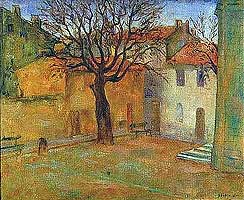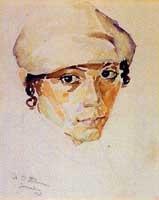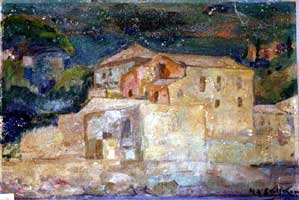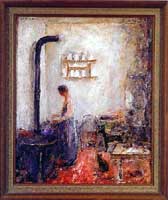
|
P U B L I C A T I O N S > R E M I N I S C E N C E S
It is quite impossible for me to convey in words
what Paris meant to Ary. One would have had to see the slow
on his face and hear the note in his voice as he spoke of the
city, which was so dear to him.
Ary's scrapbooks with catalogues and reviews
and press stories about his activities, and the books "Tetes
de Montparnasse" by Nesto Jacometti and "Artistes
Americains Modernes de Paris" by Chill Aronson, which include
Ary, cover quite well his work during those 12 years. I can
only relate some of Ary's reminiscences that may help to fill
in the picture of his personal life at that time. Through chance Ary learned of a man in Berlin
who was in financial straits and was very eager to sell an apartment
house which he owned. The price was attractively low, and Ary
managed to interest a friend, Dr. Jacques Eskin, whom he had
met on ship-board, and together they bought this property. It
was the income from this apartment house that enabled Ary to
remain in Europe for 12-1/2 years, long after his companions
Raskin and Ginsberg had returned to the United States. It meant
occasional visits to Berlin from Paris, where Ary took a studio
after spending a year in Berlin. But it was well worth his time
and effort, for it meant that he could live modestly in Paris
and travel when the spirit moved. Then began for Ary what undoubtedly was the happiest
period of his life. He was madly in love with Paris — with
her beauty, her spirit, her language, her art. Here was an ambience
in which he felt entirely at home. There was a subtlety, a refinement,
a delicacy, a "bon gout" which set every fibre of
his being to vibrating. He was suddenly set free from all the
bonds, which had been shackling him all those years in Sioux
City. Although Ary was very much an introvert he seems
to have blossomed out in every way during these years. His studio
seems to have been quite a gathering place for American artists
and their friends. Once a month, on a Saturday, he had open
house and a big crowd came, bringing food and bottles of wine
with them. The "femme de menage" who cleaned the studio
and did his laundry once a week would be on hand, and occasionally
she would bring her teenage daughter with her. Ary would ask
some of the artists to dance with the child, and the mother
would watch with tears in her eyes, proud at the honor being
done to her daughter. It was almost impossible to make her take
money for her work at such times. Ary painted many portraits at that period —his
own kind of interpretive portrait. Sometimes he would work from
the models at the Grande Chaumiere, which was near the Dome;
other times he would have models or friends pose for him in
his studio. He told me various anecdotes of these sittings —
the model who was unhappy about her too-thin breasts and who
wept for joy and embraced Ary when he painted her full-breasted;
the American woman who didn't like the double chin Ary was painting
on her portrait, and when he left the room for a minute, went
up to the canvas and tried to paint out the too heavy chin (he
ordered her out of the studio when he saw what she had done).
Ary couldn't compromise in portraits or anything else, and had
utmost scorn for pictures of pink-cheeked dowagers and dynamic-looking
businessmen. To him it must always be a composition, a work
of art, not a surface likeness. In this connection I recall
the portrait Ary painted of me the first year we were married.
He wasn't satisfied with it — I guess because he had gone
beyond the stage of enjoying this kind of work — and he
never finished it. But I remember saying to him that perhaps
it wasn't the way I looked but it was the way I felt inside
of me.
Much as Ary adored Paris,
there were times when spells of deep depression overcame him
and he locked the door of his studio and ran away. He told me
of the Christmas holidays which he spent in a little town in
Massif Central, the only guest at a little country hotel. Christmas
Eve he walked into the nearby forest and sat down under the
trees, lost in dreams and vague thought, until he fell asleep,
to be wakened by midnight chimes of Christmas bells. (The Foundation
has a Snow Scene and also a summer scene of Massif Central).
Ary told me another time of the summer when the money he had
sent for from his reserves in the States failed to arrive and
he was without funds. He had just money enough for a round trip
to a nearby country spot, a room at a small hotel, and a few
loaves of bread, and he spent several days sitting on the banks
of a little stream, thinking, drowsing and breaking off chunks
of bread to eat. Then there was the holiday when he fled in
disgust from Paris, where a group of American women friends
had ignored his advice and fallen prey to some gigolos seeking
American dollars — only to find the friend plus the gigolos
turning up at the very pension where he had taken refuge.
In 1925 Ary went by ship to
Palestine, where he remained for six months. In Jerusalem
he made dozens of watercolor sketches of the city and its types,
a crowd of youngsters usually surrounding him, and always a
self-appointed leader to drive the unruly ones away. He roamed
the hills and slept in primitive Arab towns; in one of them
he contracted malaria and was desperately ill, and there were
recurrences of the illness for years afterward. He photographed
Chaim Weizman and Lord Balfour at the opening of the Hebrew
University, for the Rotogravure Section of the New York Times.
He was asked by a prominent Arab to photograph his wife and
daughters, the first time they had unveiled their faces to a
stranger. It must have been in 1926 or '27 that Ary traveled through Spain and then down to Morocco and Fez. The Foundation has a sketchbook of pen and ink drawings recording the landscape, the architecture, and the Arab types, single or in groups. Quick sketches, they have captured the mood and character of the landscape and the people. Traveling was always an adventure for Ary, and here in northern Africa he sought out the most colorful and exotic corners he could find. In Fez he wandered through Arab sections where the French had warned Europeans not to venture. In Morocco he was drawn to the Jewish ghetto section; there he found synagogues and Hebrew schools so poor that they could not afford books for the students; the boys sat in a circle around the leader, who held a copy of the Talmud in his hands and the youngsters learned to read from whatever angle they could see the book. It was in Fez, I believe, that he attached himself to a procession that was traveling by bus to a distant cemetery where the anniversary of the birth or death of a saintly Rabbi was to be celebrated. It evidently was a spot which was supposed to have miraculous healing powers, for many sick and lame and blind were among the pilgrims. The crowd was far too big for the buses, and unfortunately the strong over-powered the sick in the rush for seats, so most of the sick and blind had to be hoisted up onto the top of the bus. Ary, as a stranger, was given a place near the driver. After a fantastic night's drive, including a change of buses in which the sick again had to be piled on the top of the bus, they reached the cemetery. There Ary met resistance and suspicion — this celebration was for Jews, and he was too pale and too foreign looking to be a Jew. Finally he persuaded them to let him enter, and he spent several days there, in the midst of a scene that harkened back to early Biblical days. People had come from miles around. The wealthy had brought their entire families with them, a retinue of servants, and food to last throughout the entire celebration period of three or four days. The servants pitched tents and prepared the food. The men ate first, then the women and children, and then the servants, and finally what was left over was turned over to the poor who had no food. At night fires were built and the men danced around the fires, singing and chanting, until they worked themselves up into a frenzy, and began to throw sacrifices into the fire — silks and other precious fabrics and gold ornaments and jewelry.
On the way back to Paris Ary
stopped at the island of Corsica. In Corsica, while he was
painting on a rocky beach he fell and broke his left arm. It
was badly set by a local doctor, and by the time Ary managed
to get back to Paris. He was in such pain that he had to go
to the American Hospital. There it was reset, but a nerve had
been caught in the first setting, and the arm was paralyzed.
The doctors held out little hope, but Ary was determined to
regain use of the arm, and once the cast was removed he began
laboriously and painfully to exercise. After three months in
the hospital, one day he thought he felt a faint tremor of life
in the arm. The doctors and nurses encouraged him, but secretly
they felt pessimistic. Christmas was approaching and Ary was
eager to spend the holidays in his own environment, so the afternoon
of Christmas Eve the doctors discharged him. He found he had
made a mistake, however. His studio was icy cold and he couldn't
make a fire in the stove. He went out to the usual cafes, but
all of his friends had gone away for the holidays. So he returned
to the freezing studio, wrapped himself up in a blanket, and
spent the most lonesome of Christmases there. I don't know how
long it took for the arm to begin to function again, but finally,
after patient exercising and many visits to the hospital Ary
could move it almost as well as before, although it always remained
weak.
Early in the 1930s Ary met the Droz family —he was a Swiss and she was a French woman, who lived in the charming and historical town of Senlis, not far from Paris. Ary was in the forest of Senlis, with paints and easel, when the Drozes and their three children, the maid and the dog, came along with picnic hampers, bound for a day's outing. They stopped to talk to Ary and invited him to join them. This was the beginning of a very happy friendship. The Drozes insisted that Ary visit them every possible weekend; the guest bedroom was set aside for him, and from one visit to another his favorite books and magazines were on the table by the bed, and everything in readiness for him. On one occasion when he had been ill they came to Paris and took him back to Senlis to recuperate. The cook fussed over him and prepared special dishes for him, especially a savory soup which Ary was very fond of. Ary's painting "The Kitchen" which he retained during the years in spite of many requests to buy it, is happily in the possession of the Foundation, and keeps alive the memory of the Droz home. They were a very cultured couple, and the fine French which Ary spoke was due greatly to their influence. (In 1952 we had a memorable reunion with the Drozes, which I have recorded in my European diary.) Ary kept a number of letters he had received from Mrs. Droz and her family. They seem to me to be so beautifully expressed, almost poetic, and they radiate such warmth and affection that one can realize what this friendship must have meant to Ary. I think the glow of this friendship must have had something to do with the luminosity of "The Kitchen." In 1932 the Paris newspapers carried highly humorous
reports of the "War of the Artists" — a battle
that took place between Ary and Joseph Stella, in front of the
Dome. Stella, enraged at having been left out of an exhibition
and related book prepared by Chil Aronson, encountered Aronson
at the cafe, and after spitting in his face grabbed him by the
coat and shook him. Aronson was only half of Stella's size,
and he seemed to Ary to need a defender, so Ary sprang up and
rushed at Stella. But Ary too was only half Stella's size, and
after he and Stella slashed at each other for a short time with
their canes, Ary went down, cut and bleeding. The police came
in and calmed things down. They wanted Ary to prefer charges
against Stella, but of course Ary wouldn't.
|
| © 2008 The Stillman-Lack Foundation, All text and images on this site may not be published, broadcast, or distributed in any form without the prior written permission of The Stillman-Lack Foundation. |




